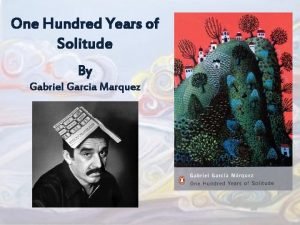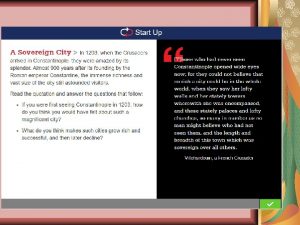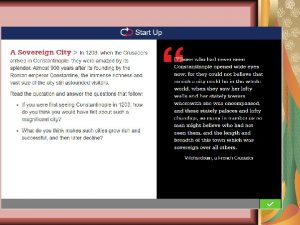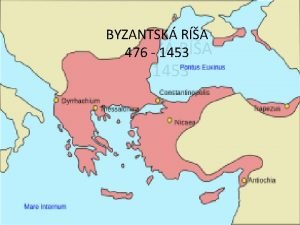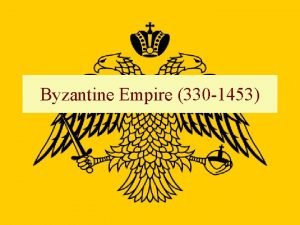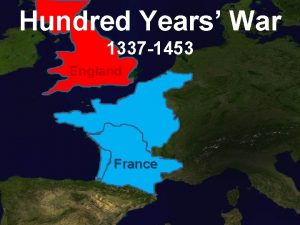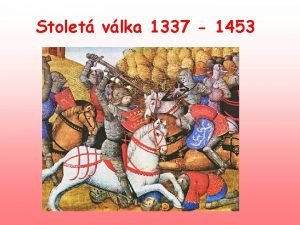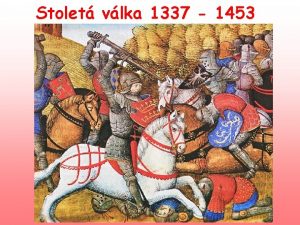The Hundred Years War 1337 1453 C E





























- Slides: 29

The Hundred Years War 1337 - 1453 C. E.

• What do you see here? • What visual clues help you distinguish between the two armies? • What is significant about the person holding the flag? • What seems to be her role in the battle? Jeanne d'Arc at the Siege of Orléans by Jules Eugene Lenepveu, painted 1886– 1890 • Why do you think the soldiers respect this woman’s leadership?

How Did the Hundred Years War Begin? In 1328, the French king Charles IV died with no male heir. He did, however, have a sister, Isabella, who had a son, Edward III, who was the King of England.


The French throne passed to the king’s nephew in France, Philip of Valois. But the grandson in England, Edward III, felt he should inherit the throne of France, as a direct heir to the king. So, in 1337 he sent a note to Philip renouncing his allegiance as a vassal to the French monarch, and claiming the French throne as the legitimate heir to Charles IV. This began a dispute over the French throne between the kings of England France. Edward’s act of renouncing his allegiance to Philip of Valois began the Hundred Years’ War.

Notes on the Hundred Years War: How did the war begin? • The French king Charles IV died in 1328 with no male heir. • Two men attempted to claim the vacant throne: Edward III of England – nephew of Charles IV Phillip of Valois (French) - cousin of Charles IV

For the first 90 years of the war, the English armies won the battles. The French knights wore extremely heavy armor. They could not move unless on their steeds.

To counter the heavy armor of the French, the English invented the long bow. It had a much greater range, it could be loaded much more quickly, it fired larger arrows that could pierce thick armor, and its bow string could be removed or replaced quickly.

The French were still using the crossbow. The original crossbows were actually very poor weapons: very slow to load, prone to misfires, and overly complicated for the generally mechanically disinclined (that is, the mechanically disadvantaged) population of the period.

The English also began employing cannons, which allowed them to blast holes in the heavily fortified walls of a castle or city. Castle of Arques la Bataille Normandy, France It was built between 1040 and 1045 C. E. During the 100 years war, this castle was the site of many confrontations between the French and English, passing frequently from one side to the other.

What were the differences between the French and the English Armies? English Army English kings created a standing army of foot soldiers recruited from the common people. English soldiers were paid to fight making them more reliable. French Army The French had an army mostly of semiindependent nobles bound only by oaths of loyalty. These oaths were often broken

Who do you think the Duke of Burgundy is loyal to: England or France? (England – because of a well established wool trade)

Notes: 100 Years War How did the nature of warfare change? • Longbows eliminated the advantages of armor. • Cannons were used to blast holes in castles. • English monarchs began to use armies recruited from common people and PAID them.

What changed? Joan of Arc put France on the path to victory. Joan of Arc was born in 1412. For the first 17 years she spent her life as a shepherd tending her father’s flocks in the Lorraine region of eastern France. In 1429, when French fortunes had sunk to their lowest point, Joan of Arc, a young peasant woman, rose to put France on the path to victory.

At 17, Joan claimed she began hearing the voices of Saint Michael, Saint Catherine, and Saint Marguerite. Each saint urged her to save France by defeating the English and retaking important cities like Rheims and Paris. Jeanne d' Arc, by Eugene Thirion (1876).

In 1429, Joan traveled to visit the uncrowned king of France, Prince Charles did not believe in her visions, and planned to play a trick on her. When she appeared at court, Charles put another man on the throne, while he stood among his nobles. But, Joan went directly to the Prince, knelt at his feet, and said, “I tell thee, on behalf of the Great Lord, that thou art the true heir of France and the son of the king. ” Now in ruins, the Great Hall of Chinon Castle is where, in 1429, Joan of Arc recognized the dauphin (prince).

From that point on, Charles supported Joan. In command of an army of 4, 000, Joan won her first battle at Orleans, defeating a larger enemy force. Next, French forces liberated Rheims, with Joan in a suit of armor at their head.

The Prince was then crowned Charles VII, King of France, in Rheims Cathedral in 1429 with Joan at his side.

French fortunes had completely changed after just two years of leadership by Joan of Arc. Her leadership turned the tide of the war in favor of the French, completely.

In early 1431 Joan of Arc was captured by citizens of Burgundy, an independent region of eastern France allied with the English. The Burgundians sold her to the English, who accused her of being a witch. Joan interrogated in her prison cell by Cardinal Winchester. By Hippolyte Delaroche, 1824

Throughout her trial, Charles VII did nothing to help or defend her, even though it was Joan’s victories that had put him on the throne and delivered France to the brink of victory. After a 5 -month trial she was found guilty of heresy. On May 30, 1431, she was burned at the stake in the main square of Rouen. Painting, ca. 1485. This is an artist's interpretation, since the only portrait for which she is known to have sat has not survived

With Joan in armor and riding a war horse at the head of the troops, the French army had pushed the British out of central France and bottled them up on the Atlantic coast. By 1453, 22 years after Joan’s death, France finally defeated England.

Notes – 100 Years War Who was Joan of Arc, and how did she change the course of the war? • She was a young French peasant woman • She convinced the French King to let her lead an army against the English in 1429. • She helped push the English armies out of central France. • She was captured by the English, accused of witchcraft, and burned at the stake in 1431.

Down with Feudal Lords; Up with Monarchs! Prior to the Hundred Years War, many French commoners had more allegiance to their local lord, and many high-ranking nobles acted practically independently of the King. After the war, however, the French people found themselves with a new sense of patriotism towards their king and their country. They became less loyal to the feudal lords of the past.

Louis XI, the king of France from 1461 - 1483 was the first French king to establish absolute power: He cemented his right to collect taxes (to finance a huge army that answered only to him, not noble lords). People became loyal to him for protection.

He reduced the military power of the nobles by enlarging a new standing army that answered only to him. He supported economic prosperity of middle class merchants, reducing the power of nobles and increasing his tax base.

In England, change also occurred. The English King, Henry VI and Parliament (the seat of government) used the war to gain power. Once they lost the war, and all the French territory, the English monarchs were able to concentrate more on the running of the country.

Notes: 100 Years War Why did the war contribute to the end of feudalism in France? • People became more patriotic, and more devoted to their king than their feudal lord. • Monarchs built huge armies with the taxes they collected, instead of relying on the loyalty of the nobles and knights.

On a clean sheet of paper, write your name, then answer 3 of these questions: • Today I learned…. • I was surprised by…. • The most useful thing I will take from this lesson is… • I was interested in… • What I liked most about this lesson was… • One thing I’m not sure about is… • The main thing I want to find out more about is… • After this lesson, I feel… • I might have gotten more from this lesson if…
 1453-1337
1453-1337 1453-1337
1453-1337 1453-1337
1453-1337 1453-1337
1453-1337 Text to leet
Text to leet One hundred years word
One hundred years word Once upon a time there was a kingdom
Once upon a time there was a kingdom Aureliano segundo
Aureliano segundo 300 solar years to lunar years
300 solar years to lunar years How long is four score and seven years?
How long is four score and seven years? Sheep years to human years
Sheep years to human years Ovidiu tanase
Ovidiu tanase Mořeplavec magalhaes
Mořeplavec magalhaes 1453-330
1453-330 The byzantine empire reached its greatest size under
The byzantine empire reached its greatest size under 1453 ce
1453 ce Ce 1453
Ce 1453 476 a 1453
476 a 1453 476 a 1453
476 a 1453 1453-330
1453-330 476 a 1453
476 a 1453 1453-395
1453-395 Ral 1453
Ral 1453 395-1453
395-1453 395-1453
395-1453 Definition of byzantium
Definition of byzantium 1453-330
1453-330 Karamanoğulları nerede kuruldu
Karamanoğulları nerede kuruldu Byzantine empire 395
Byzantine empire 395 Seven years war
Seven years war







